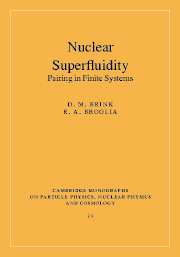Book contents
- Frontmatter
- Contents
- Preface
- 1 Introduction
- 2 The pairing force and seniority
- 3 The BCS theory
- 4 Spontaneous symmetry breaking
- 5 Pairing vibrations
- 6 Phase transitions
- 7 Plastic behaviour of nuclei and other finite systems
- 8 Sources of pairing in nuclei
- 9 Beyond mean field
- 10 Induced interaction
- 11 Pairing in exotic nuclei
- Appendix A A brief résumé of second quantization
- Appendix B Single particle in a non-local potential
- Appendix C Useful relations in the treatment of collective modes
- Appendix D Particle-vibration coupling
- Appendix E Model of the single-particle strength function
- Appendix F Simple model of Pauli principle corrections
- Appendix G Pairing mean-field solution
- Appendix H Pairing in a single j-shell
- Appendix I Fluctuations and symmetry restoration
- Appendix J RPA solution of the pairing Hamiltonian
- Appendix K Vortices in nuclei
- Appendix L Josephson effect
- References
- Index
4 - Spontaneous symmetry breaking
Published online by Cambridge University Press: 17 August 2009
- Frontmatter
- Contents
- Preface
- 1 Introduction
- 2 The pairing force and seniority
- 3 The BCS theory
- 4 Spontaneous symmetry breaking
- 5 Pairing vibrations
- 6 Phase transitions
- 7 Plastic behaviour of nuclei and other finite systems
- 8 Sources of pairing in nuclei
- 9 Beyond mean field
- 10 Induced interaction
- 11 Pairing in exotic nuclei
- Appendix A A brief résumé of second quantization
- Appendix B Single particle in a non-local potential
- Appendix C Useful relations in the treatment of collective modes
- Appendix D Particle-vibration coupling
- Appendix E Model of the single-particle strength function
- Appendix F Simple model of Pauli principle corrections
- Appendix G Pairing mean-field solution
- Appendix H Pairing in a single j-shell
- Appendix I Fluctuations and symmetry restoration
- Appendix J RPA solution of the pairing Hamiltonian
- Appendix K Vortices in nuclei
- Appendix L Josephson effect
- References
- Index
Summary
General background
As already mentioned in previous chapters, the nuclear structure exhibits many similarities with the electron structure of metals. In both cases, one is dealing with systems of fermions which may be characterized in a first approximation in terms of independent particle motion. However in both systems, important correlations in the particle motion arise from the action of the forces between particles. In particular, it is well established that nucleons moving close to the Fermi energy in time-reversal states have the tendency to form Cooper pairs which eventually condense (Bohr, Mottelson and Pines (1958), Bohr and Mottelson (1975)). This phenomenon, which has its parallel in low-temperature superconductivity, modifies the structure of nuclei in an important way. In particular it influences the occupation numbers of single-particle levels around the Fermi surface (Chapter 3), the moment of inertia of deformed nuclei (Chapter 3), the lifetime of alpha and cluster decay and fission processes (Chapter 7), the depopulation of superdeformed configurations (Chapter 6) and the cross-sections of two-nucleon transfer reactions (Chapter 5).
While one does not expect the transition between the normal and the superfluid phases of the atomic nucleus to be sharp because of finite size effects and the central role played by fluctuations (see Chapter 6), there is a strong analogy between phenomena in nuclei and the corresponding phenomena in bulk superconductors. Spontaneous symmetry breaking is important in both nuclei and superconductors.
- Type
- Chapter
- Information
- Nuclear SuperfluidityPairing in Finite Systems, pp. 72 - 91Publisher: Cambridge University PressPrint publication year: 2005



